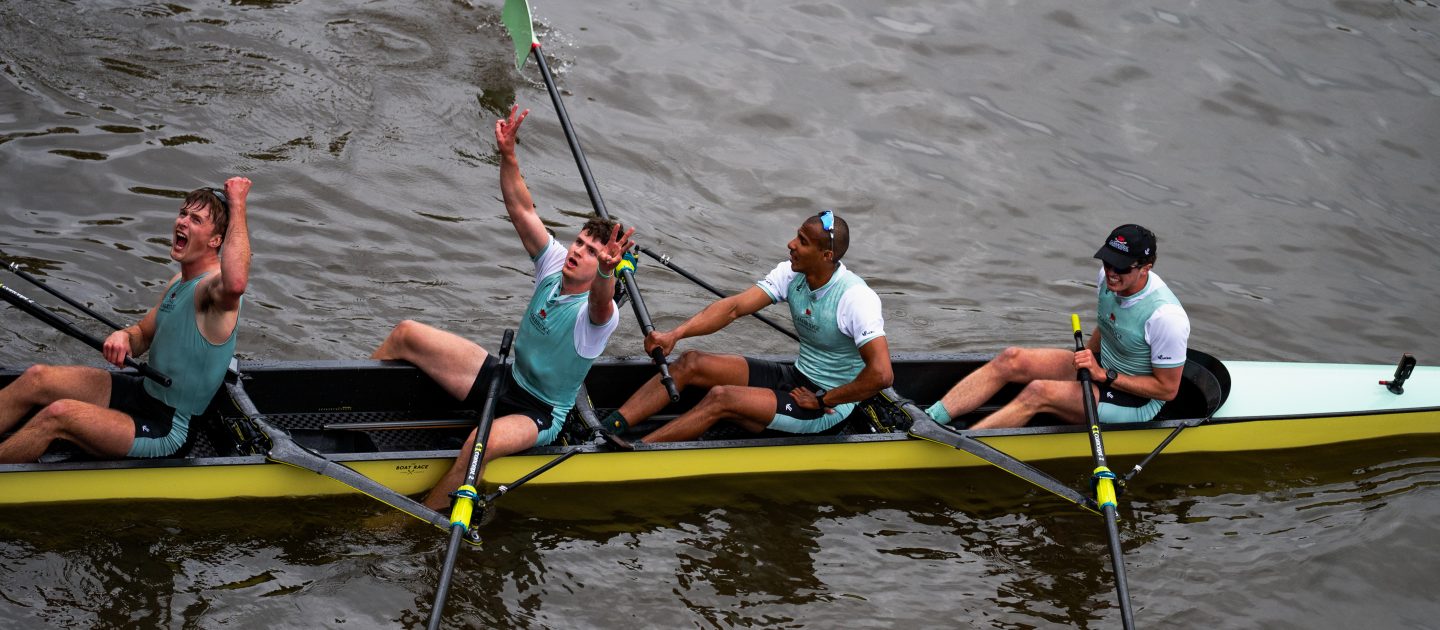Words: Simon Hatcher
When sound vanished
It was the last day of 2024, and the first day of training camp with Cambridge in Avis, Portugal. I sat at a circular table in the corner of the hotel dining room, surrounded by teammates, eating delicious food, the sun shining on my back. Suddenly, my left eardrum burst.
Rowing doesn’t seem like a sport that needs sound. Sound seems only necessary insofar as it’s the best way to convey instructions from people in charge, like a coach, a coxswain, or a mouthy crewmate. When I learned to row, I tried to get better with visual inputs. Do I see my hands raise the handle to catch at the same time that I see the stroke man place his blade? Do I watch my blade leave the water and feather at the same time as his? As that got better, my next step was to match kinaesthetic sensations with visual ones. What does it feel like to move my hands away at the same speed as the stroke man? What does it feel like to place at the same time, drive at the same time, release at the same time?
time that I see the stroke man place his blade? Do I watch my blade leave the water and feather at the same time as his? As that got better, my next step was to match kinaesthetic sensations with visual ones. What does it feel like to move my hands away at the same speed as the stroke man? What does it feel like to place at the same time, drive at the same time, release at the same time?
For years, those were the only cues I noticed: visual cues, proprioceptive cues, and aural instructions from Coach.
The morning after my eardrum burst, I had a fresh dose of antibiotics, wrapped a ridiculous bandage around my head to keep my ear dry, and got ready to row with half of my auditory input capacity out of action. I thought it wouldn’t matter. I was woefully mistaken.
There is an entire world of rowing sound, and all of it is important, from the barely-perceptible to the deafening. Especially in the Boat Race, the way each athlete manages sound can make the difference between winning and losing. Those who use aural stimulation and block out the noise retain a huge advantage.
Listening to your body
This starts at the most minute level, the most personal of sounds: the sounds of the body. On race day, the best performances are delivered by those who straddle the red line, the ragged edge of their physical capacity. This is exceptionally difficult. It’s so easy to start too hard and fall apart later; or underestimate yourself and start too easy.
This is made even more difficult by the stakes of the race and the attendant nerves. In those moments, I focus on the rhythm of the sound of my deep breaths, two per stroke, in-out-in-out. I hear my own heartbeat in my ears, beating, and I remind myself that my heart is supporting me, and I listen to its paces. Even when everything seems like chaos, the sounds of your body can keep you centred where you need to be.
The sounds of The Boat Race
Next, listen to the interfaces between you and the boat. Listen to the boat itself. Aural cues within the boat have so much to teach if you listen. In training, when the wind is still, the water bubbling and whooshing under the boat tells you where the boat is fastest and slowest in the stroke. Let that be uninterrupted, a constant humming, and you’ll know the boat is keeping its speed beautifully.
I tune to the clunk of the oarlocks, the gentle roar of wheels on tracks, and the crisp thwacks of a well-timed  blade placement to make sure I’m in time with the man in front of me.
blade placement to make sure I’m in time with the man in front of me.
Of course, just as there are the sounds of getting it right, there are the sounds of getting it wrong. You usually can’t see what you’re doing with your blade, so a thunk at the catch, a tearing through the middrive, or the splash of whitewater at the back end might be your first clue that your efficacy is slipping, and it’s time to refocus on a particular technical cue.
The sounds of the coxswain
Naturally, the most important sounds of all come through a little speaker in the bottom of the boat, courtesy of our beloved passenger princess in the stern. On the race course, when the flag has dropped, the voice of your coxswain is law, is life. S/he is the link between your internal efforts to row well and the context in which you do that.
While I think about my audio-visual and kinaesthetic rowing cues, s/he sees how those are actualized. Are we winning? Making a move? Approaching the finish line? S/he motivates me, encourages me, corrects me when I make mistakes, excites me, calms me down. This is not an ode to a coxswain (who is of course important), but an appreciation that all of that coxswain’s value comes to me aurally, through a small, tinny speaker in the bottom of the boat. The real unsung hero!
Distractions
Sound is just as important in its capacity to distract you from rowing well as it is in its capacity to help you row well. Often the loudest and most dominant auditory experiences are totally superfluous to your efforts. Wind, water, waves. Boats, cars, trains, airplanes, helicopters. Trees rustling, birds calling, cities roaring.
Shouts of “Cambridge!” or “Oxford!” or indiscriminate screaming, cheering, booing, applause, whistles. I’ve heard people yell at us: “stop rowing, you’re about to crash!” just to throw us off. (Nice try.) Sure, there are important external sounds, like the booming voice of the umpire’s warning or, in training, the voice of your coach crackling through the megaphone.
 However, for the most part, when the red flag drops, the cacophonous roar from the Putney Embankment is not your friend. It is so easy to lose your boat, your cox, your fellow rowers, yourself in the wall of noise, and the crew that finds their internal sound cues again first gets that advantage over their competitor.
However, for the most part, when the red flag drops, the cacophonous roar from the Putney Embankment is not your friend. It is so easy to lose your boat, your cox, your fellow rowers, yourself in the wall of noise, and the crew that finds their internal sound cues again first gets that advantage over their competitor.
I think anyone who’s rowed for long enough instinctively knows all of this. Indeed, perhaps I’m late to the party or have my head under a rock, and everyone else already explicitly extols the virtues and pitfalls of rowing’s many aural inputs. But on that fateful day in Portugal, as I started the warmup and realized I couldn’t hear what my blade was doing over to my left, it all became clear. Use the sounds, the rhythms, the music of rowing, and let everything else fall away. And please stay tuned for my next piece on getting a cold, losing my sense of smell, and exploring the importance of olfactory cues.



